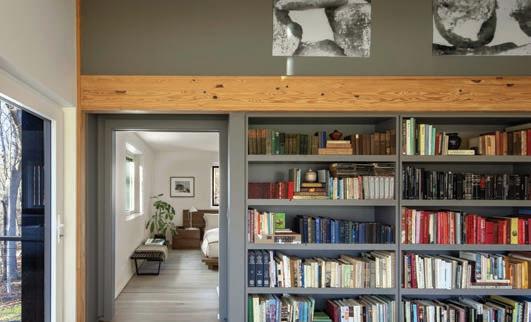
5 minute read
POSITIVELY PASSIVE
PASSIVE
The Marner House (built in 2020): Environmentally responsible, healthy, and energy efficient - a home for the future!

The architect couple designed their first home in Pound Ridge 23 years ago. After their children grew up and moved away, Larry and Elisabeth decided to build a new home for themselves, and this time their focus was on the future. Retrospectively comparing the process of designing this house to their former house, Larry says Every architect dreams of building their own home. In the case of Elisabeth Post-Marner and Larry Marner, they got to fulfill this dream - twice!

“Last time I designed a house for then. It was designed in 1998; it was for 1998. This time, in 2020,
I tried to design a house for 20 years from now.”

The duo met while studying at the Harvard Graduate School of Design. While they practice independently, both specialize in the design of responsible and sustainable buildings. Larry, the founding partner of Marner Architecture, is a
Elisabeth is a WELL Building Institute accredited professional, a specialty dedicated to improving the health and wellness of buildings for their inhabitants. Together they approached the task of designing a sustainable and healthy home from all angles, complementing each other’s skill sets and expertise.
The environmentally responsible, healthy, and energy efficient design approach is reinforced at all scales of the design, from the overall house orientation and siting to the construction details and fixture selection. In doing so, sustainability is so intrinsic to the design that it cannot be attributed to any single component, but rather every aspect of the architecture works together to reduce its impact on the environment and create a comfortable and pleasant interior. The first step of this process was distilling the area of the house down to just what is needed. This optimization allowed the house to use less building materials, thus reducing the carbon footprint; have less air volume to heat and cool, thus reducing the energy consumed, and; require less area of exterior envelope, thus reducing the potential for thermal bridging.
Passive House Institute -trained architect, meeting a rigorous standard focused on designing buildings to be self-sustaining with little reliance on active systems.




The massing of the house is divided into two congruent rectangular volumes: one for the living programs and one for the sleeping functions. These two bars are oriented deliberately to have their short ends to the east and west, reducing solar heat gain from the low rising and setting sun angles. By orienting the main expanse of glazing to the south, the house is able to use a precisely designed overhang to block high summer sunlight and harvest low winter sunlight. Between the two volumes sits the spine of the house, an axial corridor that connects the front entry to the forest beyond. Situated on a sloping hill, the entrance is on-grade with the surrounding landscape. As one moves through the house, the landscape gradually drops below the floor, leaving the back of the home elevated within the tree canopies of the adjacent forest.


Influenced by modernist masters like Le Corbusier and Mies van der Rohe, the house is designed on a modular grid. This 15’ x 15’ spacing regularizes the construction to maximize efficiency, and subdivides into smaller modules to inform the design of the interior. This level of meticulous rigor to align design and construction is consistent with the thorough approach to designing the exterior enclosure. The Marners worked closely with the builder, BPC Green Builders, to develop a live energy model of the house, evaluating the effects of changing certain components of the exterior would have on the thermal performance of the house, and the resulting energy load it would create to heat and cool. This iterative process allowed the architects to calibrate the windows’ size, specification, orientation, shading, and so on, relative to the overall envelope of the house and cost. As a result, Larry and Elisabeth were able to maximize the views of the bucolic surroundings while minimizing the active mechanical systems in the house. The stunning black wood cladding is as beautiful and timeless as it is environmentally responsible and well-performing. As an avid sailor of small boats himself, Larry was inspired to use a traditional nautical wood-sealing finish: black pine tar. Produced from decomposing pine, the finish not only protects the wood from rot and decay, but also does not emit the harmful and toxic volatile organic compounds (VOCs) found in many paints and stains. Additionally, by being produced from carbon-sequestering trees rather than fossil fuels, this finish reduces the carbon footprint of the overall construction. The drastically reduced maintenance this finish will require also means fewer materials wasted in the reapplication process, and exponentially fewer toxins emissions compared to a conventional finish.
The Marner House is a prime example of how to build a home that promotes wellness, reduces environmental impact, and offsets its consumption.

Larry said. “We did this by acting on the recent advances in building science and using a builder and an architect who are practiced at the finer construction details of the Passive House standard. When one considers that 90 percent of our time is spent indoors – and anywhere from 50% to 100% of that is at home – the case for a Net Zero Healthy Home is very compelling.”
Turquoise panels (left) and black & white mixed media panels (right) made by Peggy Weis












